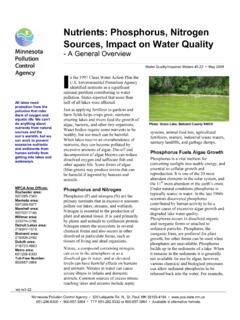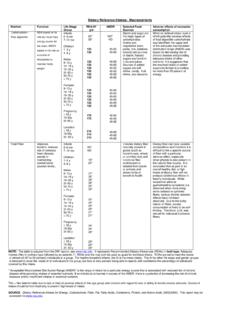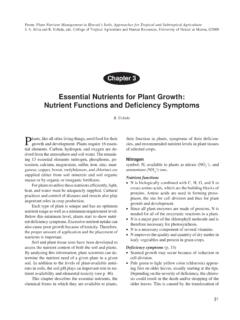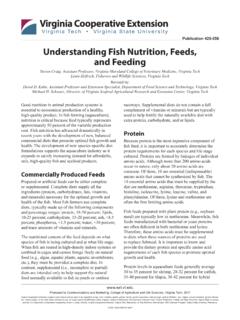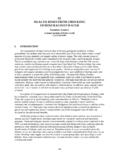Transcription of CDC’s Second Nutrition Report
1 CS229899-ANational Center for Environmental HealthDivision of Laboratory SciencesCDC s Second Nutrition Report :A comprehensive biochemical assessment of the Nutrition status of the population Report measures 58 indicators of diet and nutritionCDC s Second National Report on Biochemical Indicators of Diet and Nutrition in the Population provides reference data on biochemical indicators, including fat- and water-soluble vitamins, iron-status indicators, iodine, and other dietary biomarkers that are important to human health. Report uses NHANES resultsThe National Health and Nutrition Examination Survey (NHANES) is CDC s ongoing national survey to assess the health and Nutrition status of the population.
2 The Second Nutrition Report includes results from blood and urine samples collected from people participating in NHANES from 2003-2006. In addition, results from NHANES 1999-2002 are included for biochemical indicators measured during that time information on Nutrition deficienciesThe Second Nutrition Report found less than 10% of the population had Nutrition deficiencies for selected indicators. However, for most Nutrition indicators, deficiencies varied by age, gender, or race/ethnicity and could be as high as nearly one third of certain population groups. For example, non-Hispanic black (31%) and Mexican-American (12%) people were more likely to be vitamin D deficient compared to non-Hispanic white people (3%).
3 Nutrition deficiencies in the population<1<1< of people with Nutrition deficiencies (%) Nutrition indicators were groups ( ,1 year and older) and population groups ( , women 12-49 years of age).The graph shows prevalence estimates of Nutrition deficiencies among people who live in the (NHANES 2003-2006). Of all the nutrients listed, the most people had vitamin B6, iron, and vitamin D deficiencies, and the fewest people had vitamin A, vitamin E, and folate s Second Nutrition ReportWhat the Second Nutrition Report tells usThe Second Nutrition Report informs about the levels of biochemical indicators of diet and Nutrition in the general population and in selected groups such as children, women of childbearing age, and Second Nutrition Report provides.
4 Rates of nutrient deficiencies Reference information for physicians and scientists to detect high or low nutrient levels in people A look at nutrient levels over time to detect trends of health significance An evaluation of the effectiveness of interventions to improve the Nutrition status of the population The Nutrition status of specific populations for nutrient deficienciesVitamin D deficiency closely related to race/ethnicityBackgroundVitamin D is found naturally in only a few foods such as fish-liver oils, fatty fishes, mushrooms, egg yolks, and liver. In the United States, vitamin D commonly is added to milk and other foods. Vitamin D is essential for good bone health, and it may help with muscle strength and protecting against cancer and type 2 diabetes.
5 Ultraviolet light from the sun helps people form vitamin D in the skin. It is then transported to the liver and converted to 25-hydroxyvitamin D. Doctors use this form of vitamin D to determine whether a person has enough vitamin D because it is a good reflection of the vitamin D that people receive from food and exposure to RecommendationsDietary Guidelines for Americans indicate vitamin D is a nutrient of concern in American diets, advising that people choose foods that provide more vitamin of vitamin D deficiency by whiteMexican AmericanNon-Hispanic blackPrevalence (%)The Report found the highest rates of vitamin D deficiency in non-Hispanic blacks despite clinical data showing greater bone density and fewer fractures in this group compared to other race/ethnic groups.
6 Further research is needed on this topic. Additional information about vitamin D is available online at 3 CDC s Second Nutrition ReportFolic acid fortification: A sustained public health successBackgroundIt is especially important for people to have an adequate amount of folate in their bodies during pregnancy, infancy, and other periods when cells rapidly divide and grow. To reduce the risk of neural tube defects in newborns, the Food and Drug Administration requires folic acid be added to all enriched cereal grain blood cell folate is indicative of body folate stores and a good indicator of long-term folate status. Intake RecommendationsDietary Guidelines for Americans recommend that every woman who could become pregnant consume at least 400 micrograms of folic acid each day in addition to food forms of folate from a varied diet.
7 Pre- and post-fortification blood folate levels by race/ethnicity05010 015 020 025 030 035 019 88- 199419 99- 200220 03- 2006 Red blood cell folate (ng/mL)MexicanAmericanNon-Hi spanicblackNon-Hi spanicwh ite begins in 1998 After 1998, blood folate levels showed increases of about 50% across race/ethnic groups. Before fortification, about 10 12% of women of childbearing age did not have enough folate. After fortification, folate deficiency dropped to less than 1% in women of childbearing age of all race/ethnic groups and in the information about folate is available online at March 16th version4 CDC s Second Nutrition ReportIodine levels in young women border on insufficiencyBackgroundIodine is an essential component of thyroid hormones that regulate normal growth and development.
8 Across the world, iodized salt and seafood are generally the major dietary sources of this nutrient . In the United States, where addition of iodine to salt is not mandatory, most people get their iodine from dairy products and grains. Iodine deficiency is the most preventable cause of mental retardation in the world. Iodine deficiency can also cause hypothyroidism, goiter, cretinism, and other growth and developmental dietary iodine absorbed by the body eventually appears in the urine, so the most commonly recommended approach to determine a person s iodine status is to measure urine iodine RecommendationsThe American Thyroid Association recommends all prenatal vitamins contain 150 micrograms of iodine and that North American women receive daily dietary supplements containing 150 micrograms of iodine during pregnancy and while nursing.
9 Urine iodine levels in females by age group01002003004006-1112-1920-3940-59 Median urine iodine (ng/mL)Age (years) excessive intakeAbove requirementsAdequate intakeintakeWomen 20-39 years of age have the lowest urine iodine levels compared to all other age groups. Iodine intake in young women merits special attention to ensure the best possible brain development of the fetus during information on iodine is available online at First-time data on new indicators The Second Nutrition Report included first time measurements of new biochemical indicators: Markers of iron deficiency that improve diagnosis Healthy and unhealthy fatty acids that over time will show progress toward more heart-healthy diets Vitamins B6 and C that provide a more complete assessment of vitamin status CDC s Second Nutrition Report is available online at










